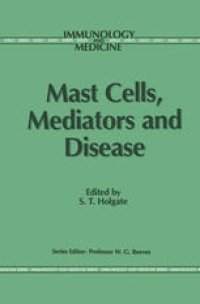
Ebook: Mast Cells, Mediators and Disease
- Tags: Immunology
- Series: Immunology and Medicine Series 7
- Year: 1988
- Publisher: Springer Netherlands
- Edition: 1
- Language: English
- pdf
In 1879 Paul Ehrlich first described the mast cell as a tissue fixed cell contain ing many granules which, when stained with basic dyes, such as toluidine blue, changed the colour spectrum of the dye in a process called meta chromasia. Since this early description, pathologists, physicians and pharmacologists have been fascinated by this cell on account of its central involvement in human allergic diseases. Approximately four decades after Ehrlich's first description of the mast cell, Prausnitz and Kiistner reported their pioneer experiment, demonstrating that the immediate skin wheal response to allergen could be passively transferred with serum. They named the antigen-specific serum factor reagin. A further four and one half decades had to pass before the connection between the mast cell and reagin could be made with the identification of reagin as an immunoglobulin E by Johansson and Ishizaka and its unique property to bind with high affinity to specific receptors on mast cells and basophils. Meanwhile in the 1920s Coca published a series of papers in which he described the clinical features of acute allergic responses and first used the term atopy. This, together with the fundamental pharmacological studies of Sir Henry Dale in identifying histamine as one mediator of the acute ana phylactic reaction, provided the second approach which eventually linked the mast cell to allergic tissue reactions. Indeed, it was Best, working in Dale's group who first showed that histamine was a chemical stored in mast cells.